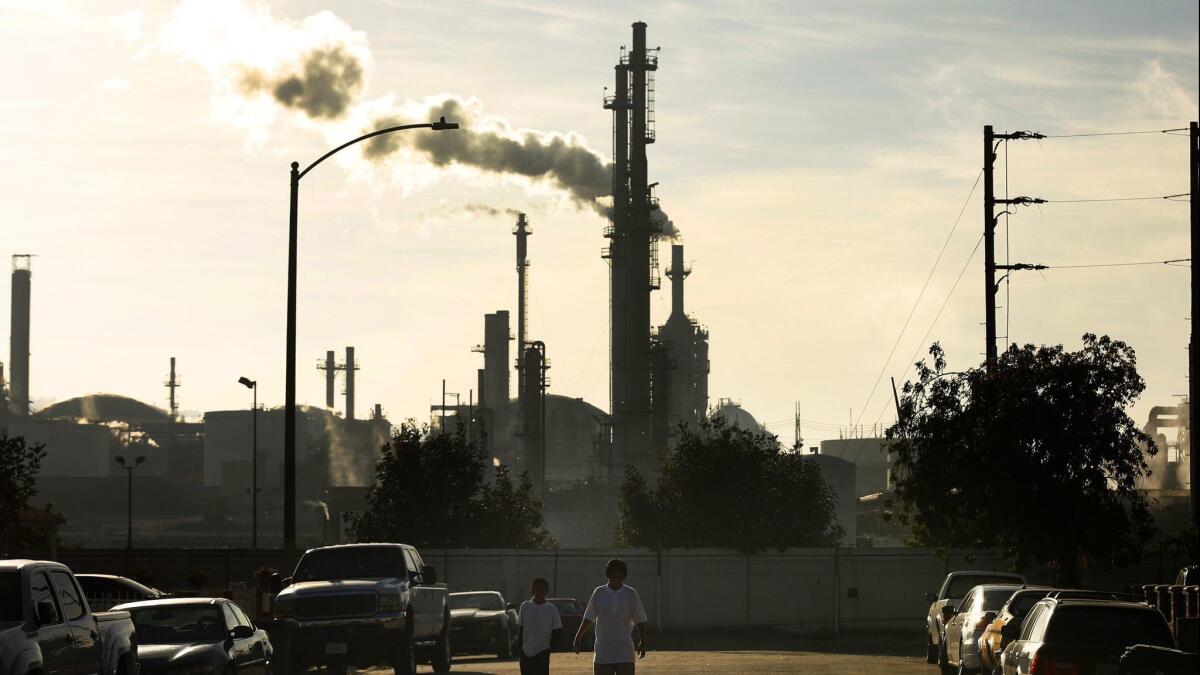Op-Ed: Until California curbs its oil refineries, it won’t meet its climate goals

While Gov. Jerry Brown and other California leaders bask under an international spotlight at this week’s Global Climate Action Summit in San Francisco, there is one highly relevant topic they’re not likely to bring up: oil refineries.
That’s because refineries are crucially absent from California’s climate change strategy. The state has justifiably gotten credit for addressing climate change issues that the nation won’t — promoting renewable energy, cap-and-trade greenhouse gas emission limits, and electric vehicles — but it has backed off from challenging refineries, the centerpieces of California’s oil supply infrastructure.
Concentrated in Los Angeles’ South Bay and the San Francisco Bay Area, the state’s 17 refineries comprise the largest oil processing center in western North America. Unless emissions from those refineries are curbed, the state has no chance of meeting its long-range climate change goals.
Greg Karras, a senior scientist at Huntington Park-based Communities for a Better Environment, calculates that without restraints on refineries, even if emission reductions from all other sources hit their targets, oil sector pollution through 2050 would cause the state to exceed its overall climate goals by roughly 40%.
Refineries have been largely exempted from the state’s cap and trade program, which charges fees for emissions.
That’s primarily because refineries have been largely exempted from the state’s cap and trade program, which charges fees for emissions. Last year, the legislature extended the program for another decade, from 2020 to 2030, but only after bowing to the oil industry’s wishes. To win a needed two-thirds majority, cap and trade supporters exempted the industry from fees for all but a tenth of refinery emissions through 2030. The legislation also prohibited regional air districts from imposing their own limits on refinery carbon dioxide emissions, a severe blow to communities suffering from pollution from nearby operations. Instead of curbing refineries, these provisions gave them a decade-long free pass.
To make matters worse, the oil that is being processed is bound to get dirtier, resulting in a higher rate of greenhouse gas emissions throughout the fuel-production chain. Oil used by the state’s refineries already contains the highest intensity of greenhouse gas pollutants of any refining region in the country. As drillers pump the dregs from the state’s nearly spent fields, that intensity is increasing.
With California oil extraction in decline, its refineries will want to import more crude oil from other states and nations. That could include tapping the Canadian tar sands, notorious for its off-the-charts, climate-busting pollutants. Completion of the stalled Trans Mountain pipeline expansion in Canada would facilitate what Greenpeace calls a “tanker superhighway” from Vancouver to California ports. California refineries have tried to win approval for rail terminals and ports that would receive tar sands oil but have so far been blocked by local governments.
The refineries’ contributions to greenhouse gas emissions don’t end with their own production, of course. When the fuel they produce is used, it’s one of the primary contributors to climate change. As California shifts to renewable energy and electric vehicles, less refined fuel will be consumed here and more will be exported to other states and nations.
As a result, the state could become, in Karras’ words, “the gas station of the Pacific Rim.” And as exports grow to countries like India with lax environmental standards, refineries won’t even need to meet California’s more stringent regulations on fuel composition; instead, they will export more pollution.
Enter the Fray: First takes on the news of the minute from L.A. Times Opinion »
The main reason state leaders have done little to limit oil supply is obvious: The oil industry remains a formidable adversary, wielding its financial and lobbying might to head off restraints. For virtually all Republican state legislators and a substantial number of Democrats, oil supply is too hot a topic to touch, Karras told me.
Meanwhile, state policy calls for greenhouse gas emissions to drop by 80% of 1990 levels by 2050. Given the oil industry’s cap and trade refinery exemptions in place through 2030, the only way to achieve that level is to place drastic limits on refineries as soon as those exemptions expire, which is unlikely to happen. A more realistic approach would remove the oil industry’s exemptions and impose cuts of 5% a year on refinery emissions immediately — an urgent task that state leaders have shown no interest in carrying out.
In the absence of action at the state level, it has fallen to localities to prevent refineries from at least increasing crude oil imports to their facilities. Over the last decade elected officials in half-a-dozen communities from Benicia to San Luis Obispo County have blocked refinery infrastructure projects that would allow more crude oil imports. They’re the real heroes of California’s climate saga — too bad they won’t be the ones in the spotlight at the summit.
Jacques Leslie is contributing writer to Opinion.
Follow the Opinion section on Twitter @latimesopinionand Facebook
More to Read
A cure for the common opinion
Get thought-provoking perspectives with our weekly newsletter.
You may occasionally receive promotional content from the Los Angeles Times.










